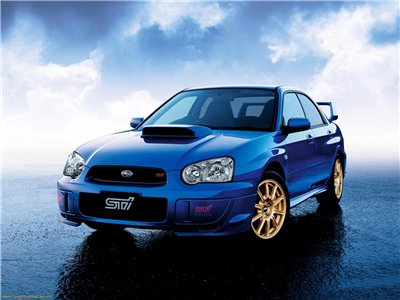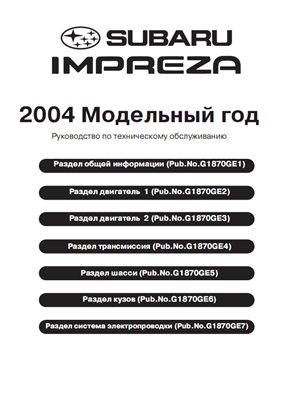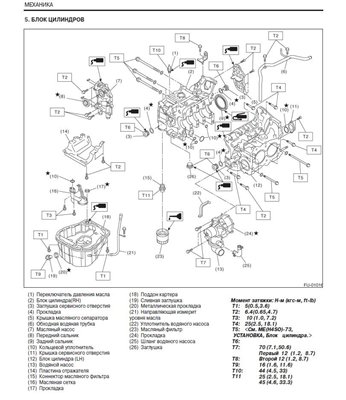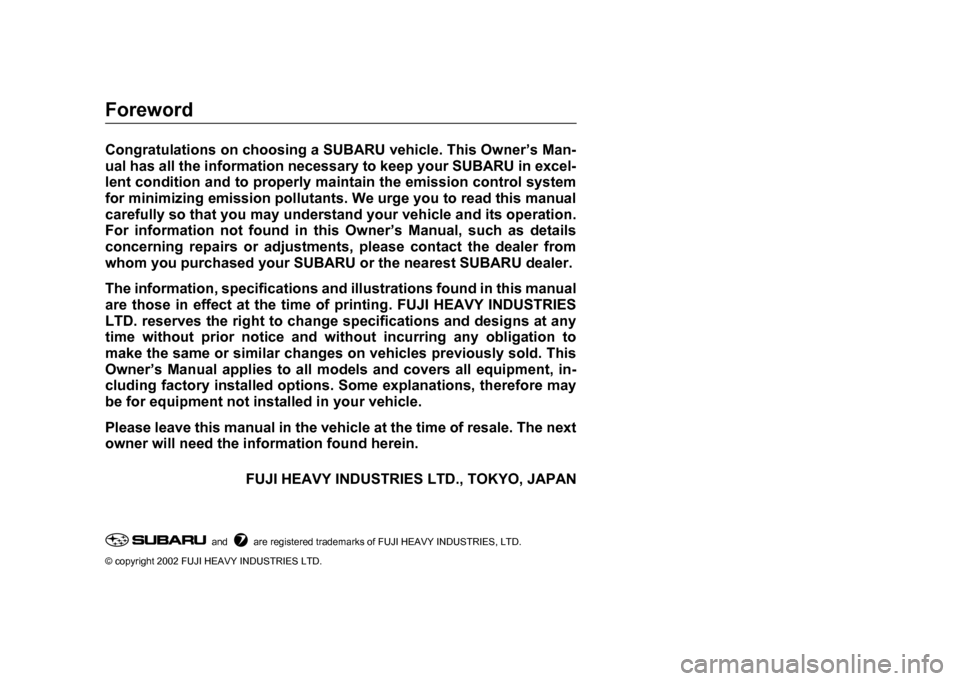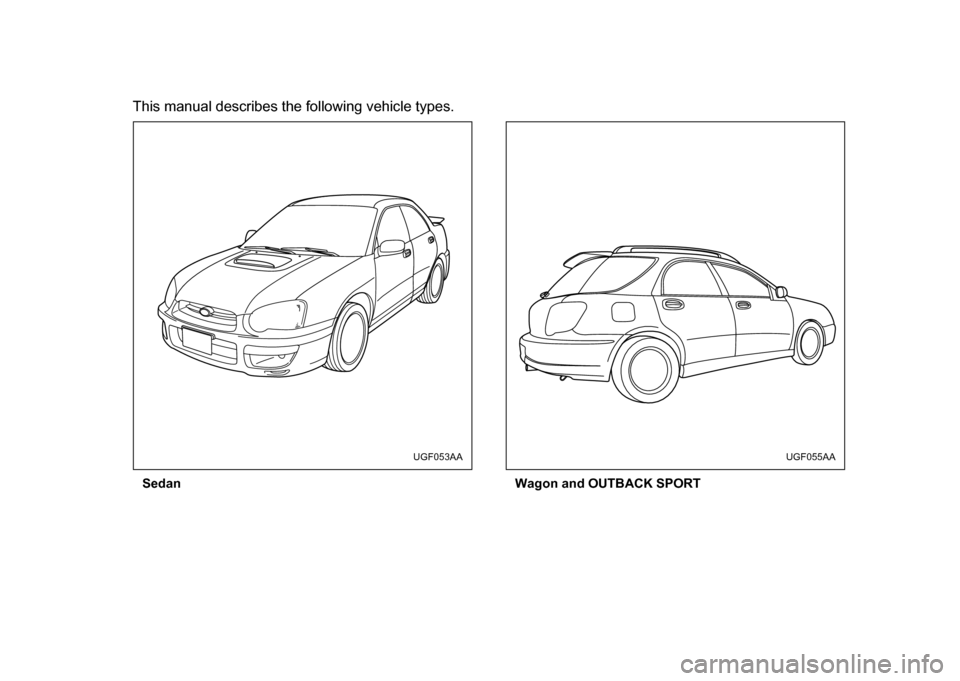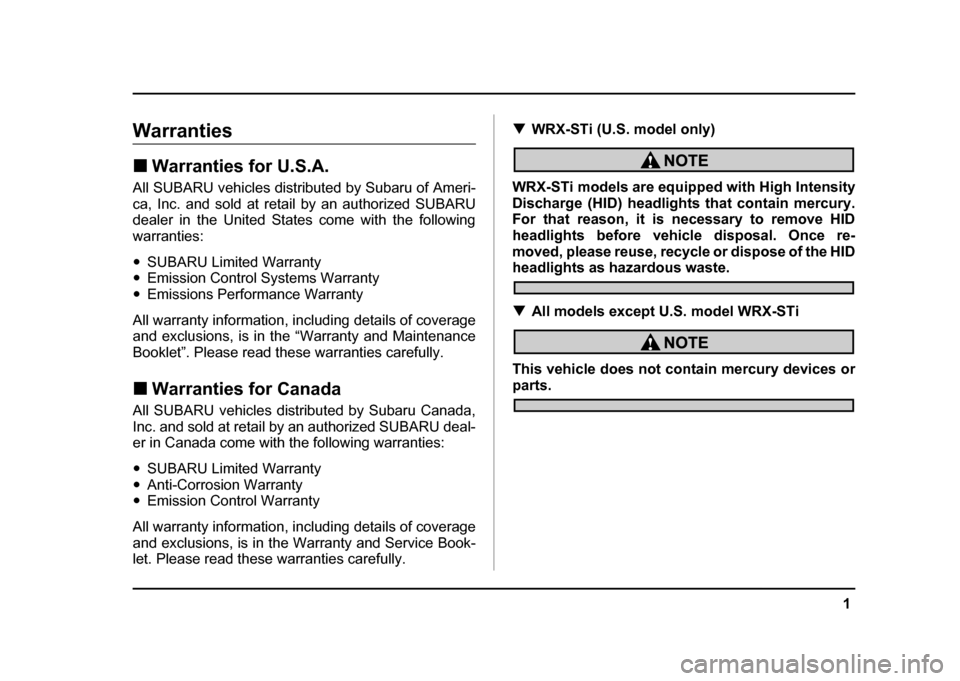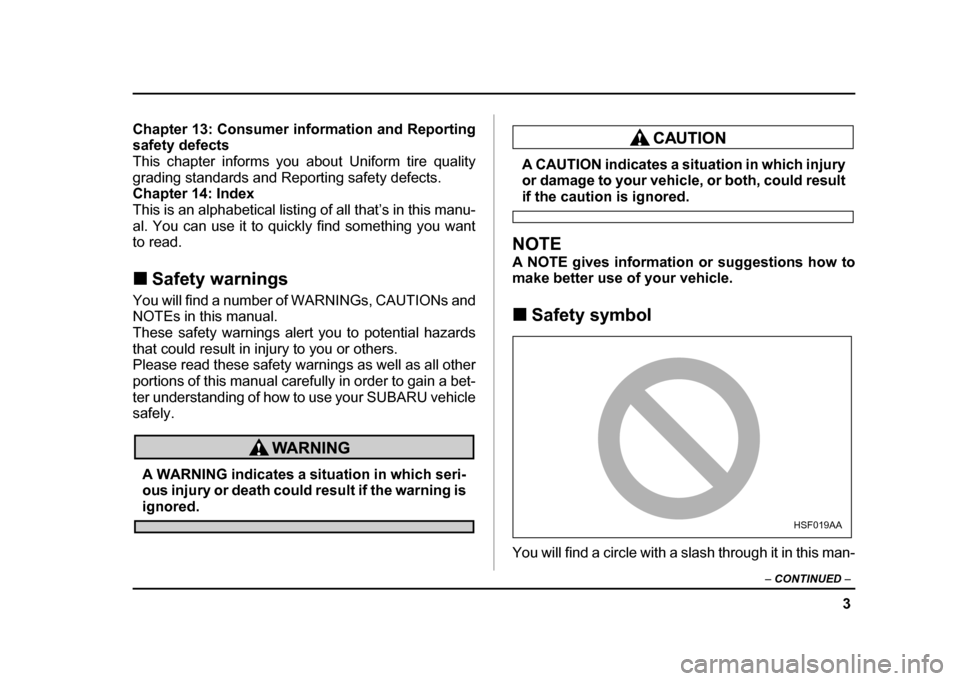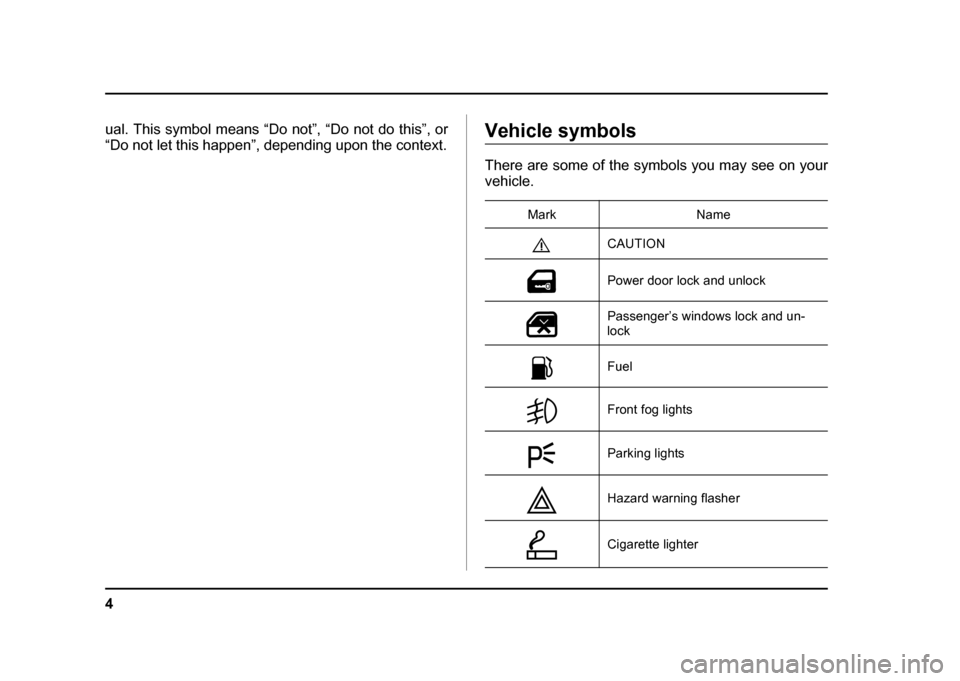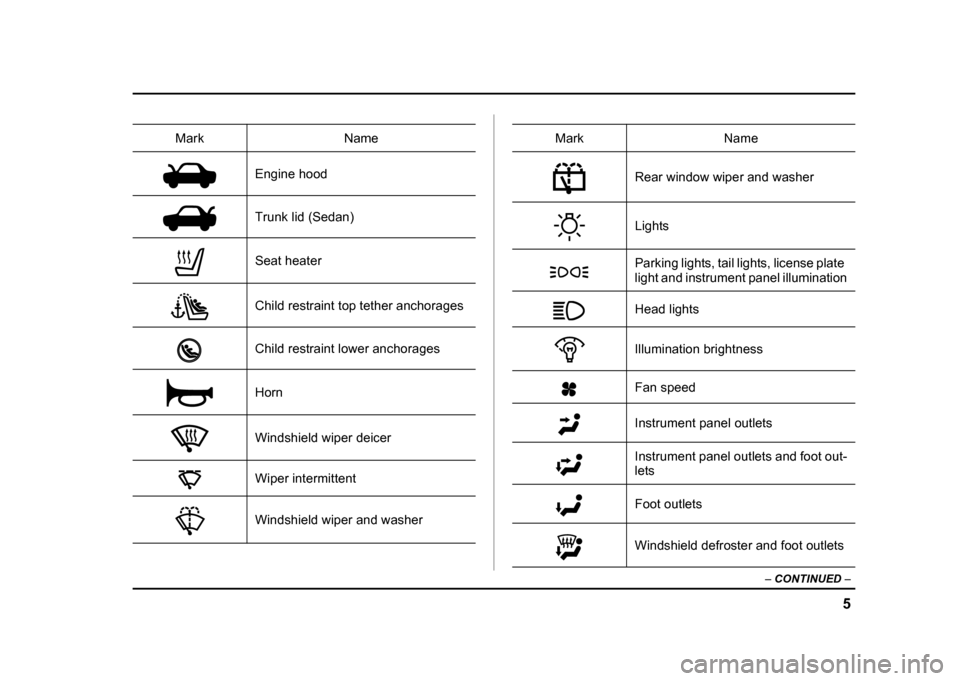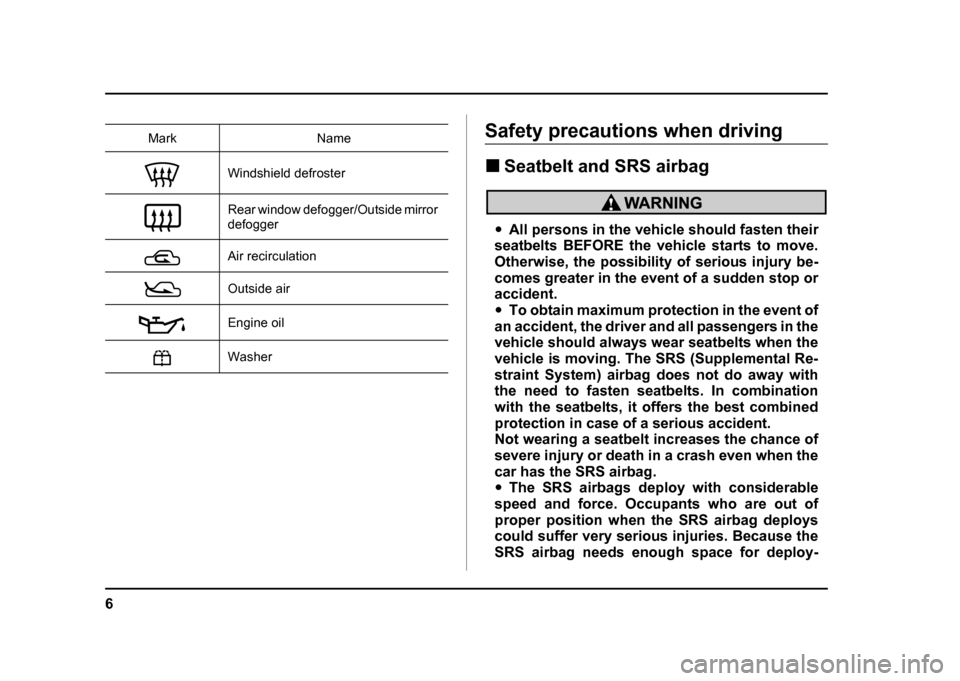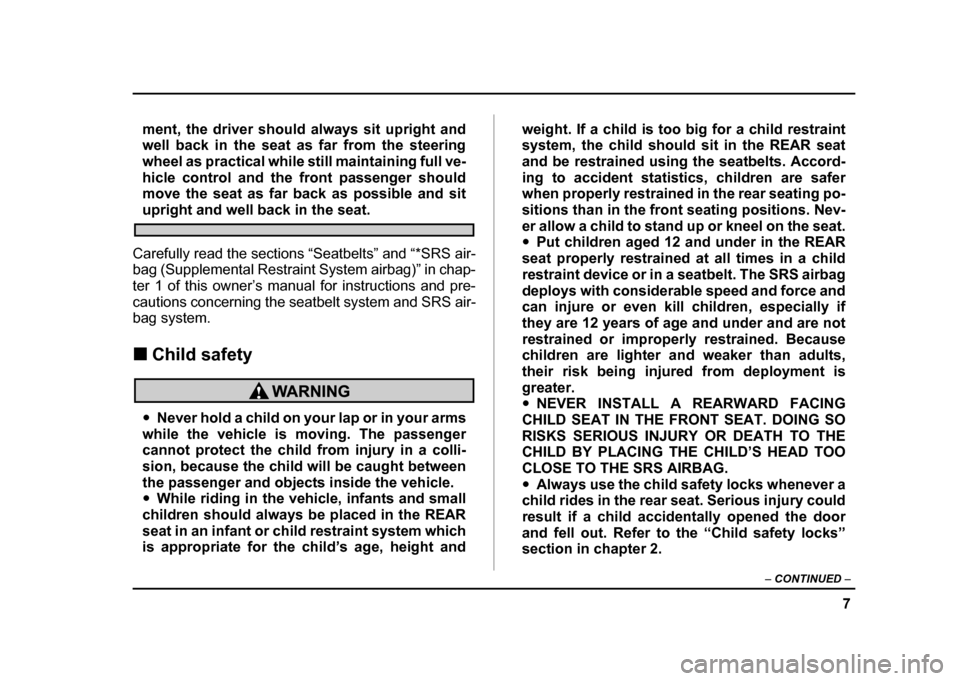
Foreword
Congratulations on choosing a SUBARU vehicle. This Owner’s Man-
ual has all the information necessary to keep your SUBARU in excel-
lent condition and to properly maintain the emission control system
for minimizing emission pollutants. We urge you to read this manual
carefully so that you may understand your vehicle and its operation.
For information not found in this Owner’s Manual, such as details
concerning repairs or adjustments, please contact the dealer from
whom you purchased your SUBARU or the nearest SUBARU dealer.
The information, specifications and illustrations found in this manual
are those in effect at the time of printing. FUJI HEAVY INDUSTRIES
LTD. reserves the right to change specifications and designs at any
time without prior notice and without incurring any obligation to
make the same or similar changes on vehicles previously sold. This
Owner’s Manual applies to all models and covers all equipment, in-
cluding factory installed options. Some explanations, therefore may
be for equipment not installed in your vehicle.
Please leave this manual in the vehicle at the time of resale. The next
owner will need the information found herein.
FUJI HEAVY INDUSTRIES LTD., TOKYO, JAPAN
and are registered trademarks of FUJI HEAVY INDUSTRIES, LTD.
© copyright 2002 FUJI HEAVY INDUSTRIES LTD.
Полный сервис-мануал по Субару Импреза 2004 модельного года, включая модели WRX и WRX STi на русском языке. Содержит описание всех систем и документцию по ремонту. Рассмотрены двигатель, подвеска, трансмиссия, полные электрические схемы, расположение жгутов, разьёмов. Приведены подробные иллюстрации, размеры, схемы, диагностические данные и методики проверок.
Год выпуска: 2004
Версия: 1.0
Совместимость с Vista: да
Формат: PDF
Язык интерфейса: только русский
Страниц: 3581
размер : 103 мб
Скачать руководство по ремонту Subaru Impreza 2004
Внимание! У Вас нет прав для просмотра скрытого текста.
Manufacturer: SUBARU, Model Year: 2004,
Model line: IMPREZA WRX,
Model: SUBARU IMPREZA WRX 2004 2.G
Pages: 491, PDF Size: 5.93 MB
Trending: Moonroof, service schedule, remote control, cooling, tire pressure, differential, service interval
Page 1 of 491
Page 2 of 491
Page 3 of 491
Page 4 of 491
Page 5 of 491
Page 6 of 491
Page 7 of 491
Page 8 of 491
Page 9 of 491
Page 10 of 491
- Load next 10 pages
Trending: brakes, remote control, Oil, display, Moonroof, transmission, oil level
View, print and download for free: SUBARU IMPREZA WRX 2004 2.G Owners Manual, 491 Pages, PDF Size: 5.93 MB. Search in SUBARU IMPREZA WRX 2004 2.G Owners Manual online. CarManualsOnline.info is the largest online database of car user manuals. SUBARU IMPREZA WRX 2004 2.G Owners Manual PDF Download.
All product names, logos, and brands are property of their respective owners.
Privacy Policy | About Us & Contact
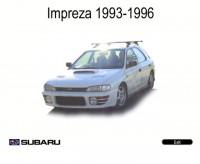
Сборник руководств на английском языке по техническому обслуживанию и ремонту автомобиля Subaru Impreza gthdjuj gjrjktybz 1996-2000 годов выпуска.
- Автор: —
- Издательство: Fuji Heavy Industries Ltd.
- Год издания: —
- Страниц: —
- Формат: PDF
- Размер: 413,7 Mb

Сборник руководств на английском языке по техническому обслуживанию и ремонту автомобилей Subaru Impreza и Subaru Impreza WRX второго поколения 2000-2007 годов выпуска.
- Автор: —
- Издательство: Fuji Heavy Industries Ltd.
- Год издания: —
- Страниц: —
- Формат: PDF
- Размер: 1,3 Gb

Сборник руководств на английском языке по техническому обслуживанию и ремонту автомобилей Subaru Impreza/Impreza WRX/Impreza WRX STI третьего поколения 2008-2014 годов выпуска.
- Автор: —
- Издательство: Fuji Heavy Industries Ltd.
- Год издания: —
- Страниц: —
- Формат: PDF
- Размер: 686,5 Mb
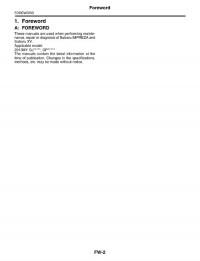
Сборник руководств на английском языке по техническому обслуживанию и ремонту автомобилей Subaru Impreza/Impreza WRX/Impreza WRX STI четвертого поколения 2013-2015 годов выпуска.
- Автор: —
- Издательство: Fuji Heavy Industries Ltd.
- Год издания: —
- Страниц: —
- Формат: PDF
- Размер: 465,8 Mb
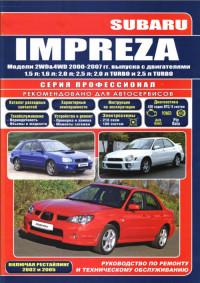
Руководство по эксплуатации, техническому обслуживанию и ремонту + каталог расходных запчастей автомобиля Subaru Impreza 2000-2007 годов выпуска с бензиновыми двигателями объемом 1,5/1,6/2,0/2,5 л.
- Автор: —
- Издательство: Легион-Автодата
- Год издания: 2014
- Страниц: 696
- Формат: —
- Размер: —

Руководство по эксплуатации и ремонту автомобилей Subaru Impreza и Subaru Impreza WRX STI с 2008 года выпуска с бензиновыми двигателями объемом 1,5/2,0/2,5 л.
- Автор: —
- Издательство: Монолит
- Год издания: —
- Страниц: 454
- Формат: —
- Размер: —
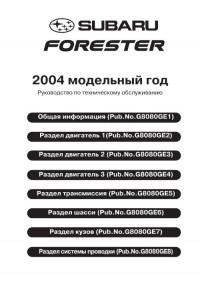
Руководство по техническому обслуживанию и ремонту автомобиля Subaru Impreza 2004 модельного года.
- Автор: —
- Издательство: Fuji Heavy Industries Ltd.
- Год издания: —
- Страниц: 3581
- Формат: PDF
- Размер: 96,7 Mb

Руководство по техническому обслуживанию и ремонту автомобиля Subaru Impreza 2008 модельного года.
- Автор: —
- Издательство: Fuji Heavy Industries Ltd.
- Год издания: —
- Страниц: 3744
- Формат: PDF
- Размер: 65,4 Mb

Руководство по эксплуатации и техническому обслуживанию автомобиля Subaru Impreza 2005 года выпуска.
- Автор: —
- Издательство: Fuji Heavy Industries Ltd.
- Год издания: 2004
- Страниц: 512
- Формат: PDF
- Размер: 10,0 Mb
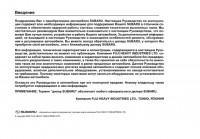
Руководство по эксплуатации и техническому обслуживанию автомобиля Subaru Impreza 2007 года выпуска.
- Автор: —
- Издательство: Fuji Heavy Industries Ltd.
- Год издания: 2006
- Страниц: 464
- Формат: PDF
- Размер: 9,3 Mb

Руководство по эксплуатации и техническому обслуживанию автомобиля Subaru Impreza 2009 года выпуска.
- Автор: —
- Издательство: Fuji Heavy Industries Ltd.
- Год издания: 2008
- Страниц: 497
- Формат: PDF
- Размер: 7,7 Mb

Руководство по эксплуатации и техническому обслуживанию автомобией Subaru Impreza и Subaru XV 2012 года выпуска.
- Автор: —
- Издательство: Fuji Heavy Industries Ltd.
- Год издания: 2011
- Страниц: —
- Формат: PDF
- Размер: 184,2 Mb
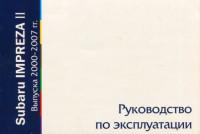
Руководство по эксплуатации и техническому обслуживанию автомобиля Subaru Impreza 2000-2007 годов выпуска.
- Автор: —
- Издательство: MoToR
- Год издания: —
- Страниц: 512
- Формат: —
- Размер: —
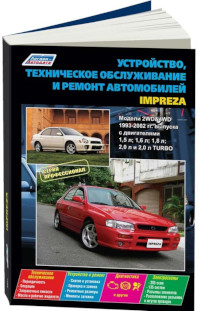
Руководство по техническому обслуживанию и ремонту автомобиля Subaru Impreza 1993-2002 годов выпуска с бензиновыми двигателями объемом 1,5/1,6/1,8/2,0 л.
- Автор: —
- Издательство: Легион-Автодата
- Год издания: —
- Страниц: 656
- Формат: —
- Размер: —
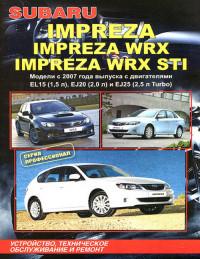
Руководство по техническому обслуживанию и ремонту автомобилей Subaru Impreza/Impreza WRX/Impreza WRX STI с 2007 года выпуска с бензиновыми двигателями объемом 1,5/2,0/2,5 л.
- Автор: —
- Издательство: Легион-Автодата
- Год издания: 2012
- Страниц: 600
- Формат: —
- Размер: —
View a manual of the Subaru Impreza WRX (2004) below. All manuals on ManualsCat.com can be viewed completely free of charge. By using the ‘Select a language’ button, you can choose the language of the manual you want to view.
Page: 1
Foreword
Congratulations on choosing a SUBARU vehicle. This Owner’s Man-
ual has all the information necessary to keep your SUBARU in excel-
lent condition and to properly maintain the emission control system
for minimizing emission pollutants. We urge you to read this manual
carefully so that you may understand your vehicle and its operation.
For information not found in this Owner’s Manual, such as details
concerning repairs or adjustments, please contact the dealer from
whom you purchased your SUBARU or the nearest SUBARU dealer.
The information, specifications and illustrations found in this manual
are those in effect at the time of printing. FUJI HEAVY INDUSTRIES
LTD. reserves the right to change specifications and designs at any
time without prior notice and without incurring any obligation to
make the same or similar changes on vehicles previously sold. This
Owner’s Manual applies to all models and covers all equipment, in-
cluding factory installed options. Some explanations, therefore may
be for equipment not installed in your vehicle.
Please leave this manual in the vehicle at the time of resale. The next
owner will need the information found herein.
FUJI HEAVY INDUSTRIES LTD., TOKYO, JAPAN
and are registered trademarks of FUJI HEAVY INDUSTRIES, LTD.
© copyright 2002 FUJI HEAVY INDUSTRIES LTD.
Page: 2
This manual describes the following vehicle types.
Sedan Wagon and OUTBACK SPORT
UGF053AA UGF055AA
Page: 3
1
– CONTINUED –
Warranties
! Warranties for U.S.A.
All SUBARU vehicles distributed by Subaru of Ameri-
ca, Inc. and sold at retail by an authorized SUBARU
dealer in the United States come with the following
warranties:
» SUBARU Limited Warranty
» Emission Control Systems Warranty
» Emissions Performance Warranty
All warranty information, including details of coverage
and exclusions, is in the “Warranty and Maintenance
Booklet”. Please read these warranties carefully.
! Warranties for Canada
All SUBARU vehicles distributed by Subaru Canada,
Inc. and sold at retail by an authorized SUBARU deal-
er in Canada come with the following warranties:
» SUBARU Limited Warranty
» Anti-Corrosion Warranty
» Emission Control Warranty
All warranty information, including details of coverage
and exclusions, is in the Warranty and Service Book-
let. Please read these warranties carefully.
! WRX-STi (U.S. model only)
WRX-STi models are equipped with High Intensity
Discharge (HID) headlights that contain mercury.
For that reason, it is necessary to remove HID
headlights before vehicle disposal. Once re-
moved, please reuse, recycle or dispose of the HID
headlights as hazardous waste.
! All models except U.S. model WRX-STi
This vehicle does not contain mercury devices or
parts.
Page: 4
2
How to use this owner’s manual
! Using your Owner’s manual
Before you operate your vehicle, carefully read this
manual. To protect yourself and extend the service life
of your vehicle, follow the instructions in this manual.
Failure to observe these instructions may result in se-
rious injury and damage to your vehicle.
This manual is composed of fourteen chapters. Each
chapter begins with a brief table of contents, so you
can usually tell at a glance if that chapter contains the
information you want.
Chapter 1: Seat, seatbelt and SRS airbags
This chapter informs you how to use the seat and seat-
belt and contains precautions for the SRS airbags.
Chapter 2: Keys and doors
This chapter informs you how to operate the keys,
locks and windows.
Chapter 3: Instruments and controls
This chapter informs you about the operation of instru-
ment panel indicators and how to use the instruments
and other switches.
Chapter 4: Climate Control
This chapter informs you how to operate the climate
control.
Chapter 5: Audio
This chapter informs you how to operate your audio
system.
Chapter 6: Interior equipment
This chapter informs you how to operate interior
equipment.
Chapter 7: Starting and operating
This chapter informs you how to start and operate your
SUBARU.
Chapter 8: Driving tips
This chapter informs you how to drive your SUBARU
in various conditions and explains some safety tips on
driving.
Chapter 9: In case of emergency
This chapter informs you what to do if you have a prob-
lem while driving, such as a flat tire or engine over-
heating.
Chapter 10: Appearance care
This chapter informs you how to keep your SUBARU
looking good.
Chapter 11: Maintenance and service
This chapter informs you when you need to take your
SUBARU to the dealer for scheduled maintenance
and informs you how to keep your SUBARU running
properly.
Chapter 12: Specifications
This chapter informs you about dimension and capac-
ities of your SUBARU.
Page: 5
3
– CONTINUED –
Chapter 13: Consumer information and Reporting
safety defects
This chapter informs you about Uniform tire quality
grading standards and Reporting safety defects.
Chapter 14: Index
This is an alphabetical listing of all that’s in this manu-
al. You can use it to quickly find something you want
to read.
! Safety warnings
You will find a number of WARNINGs, CAUTIONs and
NOTEs in this manual.
These safety warnings alert you to potential hazards
that could result in injury to you or others.
Please read these safety warnings as well as all other
portions of this manual carefully in order to gain a bet-
ter understanding of how to use your SUBARU vehicle
safely.
A WARNING indicates a situation in which seri-
ous injury or death could result if the warning is
ignored.
A CAUTION indicates a situation in which injury
or damage to your vehicle, or both, could result
if the caution is ignored.
NOTE
A NOTE gives information or suggestions how to
make better use of your vehicle.
! Safety symbol
You will find a circle with a slash through it in this man-
HSF019AA
Page: 6
4
ual. This symbol means “Do not”, “Do not do this”, or
“Do not let this happen”, depending upon the context.
Vehicle symbols
There are some of the symbols you may see on your
vehicle.
Mark Name
CAUTION
Power door lock and unlock
Passenger’s windows lock and un-
lock
Fuel
Front fog lights
Parking lights
Hazard warning flasher
Cigarette lighter
Page: 7
5
– CONTINUED –
Engine hood
Trunk lid (Sedan)
Seat heater
Child restraint top tether anchorages
Child restraint lower anchorages
Horn
Windshield wiper deicer
Wiper intermittent
Windshield wiper and washer
Mark Name
Rear window wiper and washer
Lights
Parking lights, tail lights, license plate
light and instrument panel illumination
Head lights
Illumination brightness
Fan speed
Instrument panel outlets
Instrument panel outlets and foot out-
lets
Foot outlets
Windshield defroster and foot outlets
Mark Name
Page: 8
6
Safety precautions when driving
! Seatbelt and SRS airbag
» All persons in the vehicle should fasten their
seatbelts BEFORE the vehicle starts to move.
Otherwise, the possibility of serious injury be-
comes greater in the event of a sudden stop or
accident.
» To obtain maximum protection in the event of
an accident, the driver and all passengers in the
vehicle should always wear seatbelts when the
vehicle is moving. The SRS (Supplemental Re-
straint System) airbag does not do away with
the need to fasten seatbelts. In combination
with the seatbelts, it offers the best combined
protection in case of a serious accident.
Not wearing a seatbelt increases the chance of
severe injury or death in a crash even when the
car has the SRS airbag.
» The SRS airbags deploy with considerable
speed and force. Occupants who are out of
proper position when the SRS airbag deploys
could suffer very serious injuries. Because the
SRS airbag needs enough space for deploy-
Windshield defroster
Rear window defogger/Outside mirror
defogger
Air recirculation
Outside air
Engine oil
Washer
Mark Name
Page: 9
7
– CONTINUED –
ment, the driver should always sit upright and
well back in the seat as far from the steering
wheel as practical while still maintaining full ve-
hicle control and the front passenger should
move the seat as far back as possible and sit
upright and well back in the seat.
Carefully read the sections “Seatbelts” and “*SRS air-
bag (Supplemental Restraint System airbag)” in chap-
ter 1 of this owner’s manual for instructions and pre-
cautions concerning the seatbelt system and SRS air-
bag system.
! Child safety
» Never hold a child on your lap or in your arms
while the vehicle is moving. The passenger
cannot protect the child from injury in a colli-
sion, because the child will be caught between
the passenger and objects inside the vehicle.
» While riding in the vehicle, infants and small
children should always be placed in the REAR
seat in an infant or child restraint system which
is appropriate for the child’s age, height and
weight. If a child is too big for a child restraint
system, the child should sit in the REAR seat
and be restrained using the seatbelts. Accord-
ing to accident statistics, children are safer
when properly restrained in the rear seating po-
sitions than in the front seating positions. Nev-
er allow a child to stand up or kneel on the seat.
» Put children aged 12 and under in the REAR
seat properly restrained at all times in a child
restraint device or in a seatbelt. The SRS airbag
deploys with considerable speed and force and
can injure or even kill children, especially if
they are 12 years of age and under and are not
restrained or improperly restrained. Because
children are lighter and weaker than adults,
their risk being injured from deployment is
greater.
» NEVER INSTALL A REARWARD FACING
CHILD SEAT IN THE FRONT SEAT. DOING SO
RISKS SERIOUS INJURY OR DEATH TO THE
CHILD BY PLACING THE CHILD’S HEAD TOO
CLOSE TO THE SRS AIRBAG.
» Always use the child safety locks whenever a
child rides in the rear seat. Serious injury could
result if a child accidentally opened the door
and fell out. Refer to the “Child safety locks”
section in chapter 2.
Page: 10
8
» Always lock the passenger’s windows using
the lock switch when children are riding in the
vehicle. Failure to follow this procedure could
result in injury to a child operating the power
window. Refer to the “Windows” section in
chapter 2.
» Never leave unattended children in the vehi-
cle. They could accidentally injure themselves
or others through inadvertent operation of the
vehicle. Also, on hot or sunny days, tempera-
ture in a closed vehicle could quickly become
high enough to cause severe or possibly fatal
injuries to them.
» Help prevent young children from locking
themselves in the trunk. When leaving the vehi-
cle, either close all windows and lock all doors
or cancel the inside trunk lid release. Also make
certain that the trunk is closed. On hot or sunny
days, the temperature in a trunk could quickly
become high enough to cause death or serious
heat-related injuries including brain damage,
particularly for small children.
Carefully read the sections “Child restraint systems”,
“*SRS airbag (Supplemental Restraint System air-
bag)”, and “Seatbelts” in chapter 1 of this owner’s
manual for instructions and precautions concerning
the child restraint system, seatbelt system and SRS
airbag system.
! Engine exhaust gas (carbon monox-
ide)
» Never inhale engine exhaust gas. Engine ex-
haust gas contains carbon monoxide, a color-
less and odorless gas which is dangerous, or
even lethal, if inhaled.
» Always properly maintain the engine exhaust
system to prevent engine exhaust gas from en-
tering the vehicle.
» Never run the engine in a closed space, such
as a garage, except for the brief time needed to
drive the vehicle in or out of it.
» Avoid remaining in a parked vehicle for a
lengthy time while the engine is running. If that
is unavoidable, then use the ventilation fan to
force fresh air into the vehicle.
» Always keep the front ventilator inlet grille
free from snow, leaves or other obstructions to
ensure that the ventilation system always
works properly.
» If at any time you suspect that exhaust fumes
Page: 11
9
– CONTINUED –
are entering the vehicle, have the problem
checked and corrected as soon as possible. If
you must drive under these conditions, drive
only with all windows fully open.
» Keep the trunk lid or rear gate closed while
driving to prevent exhaust gas from entering
the vehicle.
! Drinking and driving
Drinking and then driving is very dangerous.
Alcohol in the bloodstream delays your reac-
tion and impairs your perception, judgment and
attentiveness. If you drive after drinking – even
if you drink just a little – it will increase the risk
of being involved in a serious or fatal accident,
injuring or killing yourself, your passengers
and others. In addition, if you are injured in the
accident, alcohol may increase the severity of
that injury.
Please don’t drink and drive.
Drunken driving is one of the most frequent causes of
accidents. Since alcohol affects all people differently,
you may have consumed too much alcohol to drive
safely even if the level of alcohol in your blood is below
the legal limit. The safest thing you can do is never
drink and drive. However if you have no choice but to
drive, stop drinking and sober up completely before
getting behind the wheel.
! Drugs and driving
There are some drugs (over the counter and
prescription) that can delay your reaction time
and impair your perception, judgment and at-
tentiveness. If you drive after taking them, it
may increase your, your passengers’ and other
persons’ risk of being involved in a serious or
fatal accident.
If you are taking any drugs, check with your doctor or
pharmacist or read the literature that accompanies the
medication to determine if the drug you are taking can
impair your driving ability. Do not drive after taking any
medications that can make you drowsy or otherwise
affect your ability to safely operate a motor vehicle. If
Page: 12
10
you have a medical condition that requires you to take
drugs, please consult with your doctor.
Never drive if you are under the influence of any illicit
mind-altering drugs. For your own health and well-be-
ing, we urge you not to take illegal drugs in the first
place and to seek treatment if you are addicted to
those drugs.
! Driving when tired or sleepy
When you are tired or sleepy, your reaction will
be delayed and your perception, judgment and
attentiveness will be impaired. If you drive
when tired or sleepy, your, your passengers’
and other persons’ chances of being involved
in a serious accident may increase.
Please do not continue to drive but instead find a safe
place to rest if you are tired or sleepy. On long trips,
you should make periodic rest stops to refresh your-
self before continuing on your journey. When possible,
you should share the driving with others.
! Modification of your vehicle
Your vehicle should not be modified. Modifica-
tion could affect its performance, safety or du-
rability, and may even violate governmental
regulations. In addition, damage or perfor-
mance problems resulting from modification
may not be covered under warranties.
! Mobile phones and driving
Do not use a hand-held phone while driving; it
may distract your attention from driving and
can lead to an accident. If you use a hand-held
phone, pull off the road and park in the safe
place before using your phone. In some States/
Provindes, only hands-free phones may legally
be used while driving.
Page: 13
11
– CONTINUED –
! Driving with pets
Unrestrained pets can interfere with your driving and
distract your attention from driving. In a collision or
sudden stop, unrestrained pets or cages can be
thrown around inside the vehicle and hurt you or your
passengers. Besides, the pets can be hurt under
these situations. It is also for their own safety that pets
should be properly restrained in your vehicle. Restrain
a pet with a special traveling harness which can be se-
cured to the rear seat with a seatbelt or use a pet car-
rier which can be secured to the rear seat by routing a
seatbelt through the carrier’s handle. Never restrain
pets or pet carriers in the front passenger’s seat. For
further information, consult your veterinarian, local an-
imal protection society or pet shop.
! Tire pressures
Check and, if necessary, adjust the pressure of each
tire (including the spare) at least once a month and be-
fore any long journey.
Check the tire pressure when the tires are cold. Use a
pressure gauge to adjust the tire pressures to the val-
ues shown on the tire placard.
Refer to the “Tires and wheels” section in chapter 11
for detailed information.
Driving at high speeds with excessively low tire
pressures can cause the tires to deform severe-
ly and to rapidly become hot. A sharp increase
in temperature could cause tread separation,
and destruction of the tires. The resulting loss
of vehicle control could lead to an accident.
! California proposition 65 warning
Engine exhaust, some of its constituents, and
certain vehicle components contain or emit
chemicals known to the State of California to
cause cancer and birth defects or other repro-
ductive harm. In addition, certain fluids in vehi-
cles and certain components of product wear
contain or emit chemicals known to the State of
California to cause cancer and birth defects or
other reproductive harm.
Page: 14
14
9
12
8
1
2
3
4
5
6
7
13
10
11
Table of contents
Seat, seatbelt and SRS airbags
Keys and doors
Instruments and controls
Climate control
Audio
Interior equipment
Starting and operating
Driving tips
In case of emergency
Appearance care
Maintenance and service
Specifications
Consumer information and Reporting safety defects
Index
Page: 15
14
Illustrated index
! Exterior
10
12 11 8 7
9 6
5
4
3
1 2
UGF054BB
1) Engine hood (page 11-5)
2) Headlight switch (page 3-29)
3) Replacing bulbs (page 11-64)
4) Wiper switch (page 3-37)
5) Moonroof (page 2-31)
6) Door locks (page 2-3)
7) Tire pressure (page 11-45)

9) Tire chains (page 8-16)
10) Front fog light switch (page 3-
35)
11) Tie-down hooks (page 9-17)
12) Towing hooks (page 9-17)
Page: 16
15
– CONTINUED –
1 2
3 4 4
6 2 3
4
4 5
1 7
UGF502BB
1) Rear window defogger switch
(page 3-40)
2) Fuel filler lid and cap (page 7-4)
3) Child safety locks (page 2-21)
4) Tie-down/Towing hook (page 9-
18)
5) Trunk lid (page 2-25)
6) Rear gate (page 2-29)
7) Roof rail (page 8-21)
Page: 17
16
! Interior
! Passenger compartment area
1 2
3
4
5
UGF506BB
1) Lower anchorage for child re-
straint system (page 1-42)
2) Seatbelt (page 1-13)
3) Parking brake lever (page 7-34)
4) Front seat (page 1-2)
5) Rear seat (page 1-8)
Page: 18
17
– CONTINUED –
3
2
5
4
1
UGF507BB
1) Cup holder (page 6-7)
2) Center console (page 6-6)
3) Glove box (page 6-6)
4) Cigarette lighter (page 6-10)
5) Ashtray (page 6-12)
Page: 19
18
! Instrument panel
1 2 3 4 5 6
7
8
9
11
12
13
14
15
16 10
UGF056BB
1) Door locks (page 2-3)
2) Light control lever (page 3-29)
3) Combination meter (page 3-15)
4) Wiper control lever (page 3-35)
5) Hazard warning flasher switch
(page 3-6)
6) Audio (page 5-1)
7) Gear shift lever (MT) (page 7-
15)/Selector lever (AT) (page 7-
21)

48)
9) Climate control (page 4-1)
10) Cruise control (page 7-37)
11) Horn (page 3-50)
12) SRS airbag (page 1-52)
13) Tilt steering (page 3-49)
14) Fuse box (page 11-60)
15) Hood lock release (page 11-5)
16) Power window (page 2-22)
Page: 20
19
– CONTINUED –
! Light control and wiper control levers/switches
2
3
4
5
6
7
8
9
10
11
12
1
HSF025BB
1) Parking light switch (page 3-34)
2) Windshield wiper (page 3-37)
3) Mist (page 3-38)
4) Windshield washer (page 3-38)
5) Rear window wiper and washer
switch (page 3-39)
6) Wiper control lever (page 3-37)
7) Illumination brightness control
(page 3-32)

9) Headlight ON/OFF (page 3-29)
10) Headlight flasher High/Low
beam change (page 3-29)
11) Turn signal (for lane change)
(page 3-31)
12) Turn signal (page 3-31)
Page: 21
20
! Combination meter
! WRX
1
8 6
7
2 3 5
4
UGF050BB
1) Fuel gauge (page 3-16)
2) Selector lever position indicator
(page 3-26)
3) Temperature gauge (page 3-17)
4) Tachometer (page 3-16)
5) Speedometer (page 3-15)
6) Odometer and trip meter (page
3-15)
7) Trip meter A/B selection and trip
meter reset knob (page 3-15)

17)
Page: 22
21
– CONTINUED –
! WRX-STi version
1 2 4
3 5 6
10 9 8 7
UGF051BB
1) Fuel gauge (page 3-9)
2) DCCD indicator (page 3-27)
3) Temperature gauge (page 3-10)
4) Tachometer (page 3-9)
5) REV indicator (page 3-12)
6) Speedometer (page 3-7)
7) Odometer and trip meter (page
3-8)

meter reset knob (page 3-8)
9) Ambient temperature indicator
(page 3-11)
10) Low fuel warning light (page 3-
10)
Page: 23
22
! Except turbo models
A
1
9 8 7 6
3
2 4 5
UGF052BB
1) Fuel gauge (page 3-16)
2) Selector lever position indicator
(page 3-26)
3) Temperature gauge (page 3-17)
4) Speedometer (page 3-15)
5) Tachometer (page 3-16)
6) Trip meter A/B selection and trip
meter reset knob (page 3-15)
7) Odometer and trip meter (page
3-15)

(page 3-18)
9) Low fuel warning light (page 3-
17)
Page: 24
23
– CONTINUED –
! Warning and indicator light
Mark Name Page
Seatbelt warning light 3-19
SRS airbag system warning
light
3-20
CHECK ENGINE warning light/
Malfunction indicator lamp
3-20
Charge warning light 3-21
Oil pressure warning light 3-21
AT OIL temperature warning
light (if equipped)
3-22
or ABS warning light 3-23
or Brake system warning light 3-24
Door open warning light 3-25
Front-wheel drive warning light
(if equipped)
3-25
Turn signal indicator lights 3-26
High beam indicator light 3-26
Security system indicator light
(if equipped)
2-14
Intercooler water spray warn-
ing light (if equipped)
3-25
Light indicator light
(if equipped)
3-27
Cruise control indicator light
(if equipped)
3-26
Cruise control set indicator
light
3-26
REV indicator light
(if equipped)
3-27
Rear differential oil tempera-
ture warning light (if equipped)
3-22
Electronic driver’s control cen-
ter differential auto indicator (if
equipped)
3-26
Mark Name Page
Page: 25
24
! Tire changing tools
1
2
3
1
2
3
UGF512BB
1) Jack (page 9-24)
2) Jack handle (page 9-24)
3) Spare tire (page 9-24)
Page: 26
1-1
1
Seat, seatbelt and SRS airbags
Front seats ……………………………………………. 1-2
Fore and aft adjustment …………………………….. 1-3
Reclining the seatback ………………………………. 1-4
Seat cushion height adjustment (driver’s seat) 1-5
Head restraint adjustment (if equipped) ……… 1-5
Active head restraint (if equipped) ……………… 1-6
Seat heater (if equipped) ………………………… 1-7
Rear seats …………………………………………….. 1-8
Armrest (if equipped) …………………………………. 1-9
Headrest adjustment – Wagon …………………… 1-11
Folding down the rear seat – Wagon ………….. 1-12
Seatbelts ………………………………………………. 1-13
Seatbelt safety tips ……………………………………. 1-13
Emergency Locking Retractor (ELR) ………….. 1-14
Automatic/Emergency Locking Retractor
(A/ELR) …………………………………………………… 1-15
Seatbelt warning light and chime …………… 1-15
Fastening the seatbelt ……………………………….. 1-15
Seatbelt maintenance ………………………………… 1-27
Front seatbelt pretensioners ………………….. 1-27
System monitors ……………………………………….. 1-29
System servicing ………………………………………. 1-29
Precautions against vehicle modification …… 1-30
Child restraint systems ………………………….. 1-31
Where to place a child restraint system ……… 1-33
Choosing a child restraint system ……………… 1-34
Installing child restraint systems with A/ELR
seatbelt …………………………………………………… 1-35
Installing a booster seat …………………………….. 1-40
Installation of child restraint systems by
use of lower and tether anchorages (LATCH) 1-42
Top tether anchorages ………………………………. 1-46
SRS airbag
(Supplemental Restraint System airbag) 1-52
Vehicle with driver’s and front passenger’s
SRS airbags and lap/shoulder restraints ….. 1-52
SRS frontal airbag …………………………………….. 1-56
SRS side airbag (if equipped) …………………….. 1-64
SRS airbag system monitors ……………………… 1-72
SRS airbag system servicing …………………….. 1-73
Precautions against vehicle modification …… 1-74
Page: 27
1-2
Seat, seatbelt and SRS airbags
Seat, seatbelt and SRS airbags
Front seats
» Never adjust the seat while driving to avoid
the possibility of loss of vehicle control and of
personal injury.
» Before adjusting the seat, make sure the
hands and feet of rear seat passengers are
clear of the adjusting mechanism.
» Seatbelts provide maximum restraint when
the occupant sits well back and upright in the
seat. To reduce the risk of sliding under the
seatbelt in a collision, the front seatbacks
should be always used in the upright position
while the vehicle is running. If the front seat-
backs are not used in the upright position in a
collision, the risk of sliding under the lap belt
and of the lap belt sliding up over the abdomen
will increase, and both can result in serious in-
ternal injury or death.
Put children aged 12 and under in the rear seat
properly restrained at all times. The SRS airbag
deploys with considerable speed and force and
can injure or even kill children, especially if
they are 12 years of age and under and are not
restrained or improperly restrained. Because
children are lighter and weaker than adults,
their risk of being injured from deployment is
greater. For that reason, we strongly recom-
mend that ALL children (including those in
child seats and those that have outgrown child
restraint devices) sit in the REAR seat properly
HS1034BA
Page: 28
1-3
Seat, seatbelt and SRS airbags
– CONTINUED –
restrained at all times in a child restraint device
or in a seatbelt, whichever is appropriate for the
child’s age, height and weight. Secure ALL
types of child restraint devices (including for-
ward facing child seat) in the REAR seats at all
times.
NEVER INSTALL A REARWARD FACING CHILD
SEAT IN THE FRONT SEAT. DOING SO RISKS
SERIOUS INJURY OR DEATH TO THE CHILD
BY PLACING THE CHILD’S HEAD TOO CLOSE
TO THE SRS AIRBAG.
According to accident statistics, children are
safer when properly restrained in the rear seat-
ing positions than in the front seating posi-
tions. For instructions and precautions con-
cerning child restraint systems, see the “Child
restraint systems” section in this chapter.
! Fore and aft adjustment
Pull the lever upward and slide the seat to the desired
position. Then release the lever and move the seat
back and forth to make sure that it is securely locked
into place.
UG1501BA
Page: 29
1-4
Seat, seatbelt and SRS airbags
! Reclining the seatback
Pull the reclining lever up and adjust the seatback to
the desired position. Then release the lever and make
sure the seatback is securely locked into place.
The seatback placed in a reclined position can spring
back upward with force when released. When operat-
ing the reclining lever to return the seatback, hold it
lightly so that it may be raised back gradually.
To prevent the passenger from sliding under
the seatbelt in the event of a collision, always
put the seatback in the upright position while
the vehicle is in motion. Also, do not place ob-
jects such as cushions between the passenger
and the seatback. If you do so, the risk of slid-
ing under the lap belt and of the lap belt sliding
up over the abdomen will increase, and both
can result in serious internal injury or death.
UG1502BA
HS1037BA
Page: 30
1-5
Seat, seatbelt and SRS airbags
– CONTINUED –
! Seat cushion height adjustment (driv-
er’s seat)
1) When the lever is pushed down, the seat is lowered.
2) When the lever is pulled up, the seat rises.
The height of the seat can be adjusted by moving the
seat cushion adjustment lever up and down.
! Head restraint adjustment (if
equipped)
To raise the head restraint, pull it up.
To lower it, push the head restraint down while press-
ing the release button on the top of the seatback.
The head restraint should be adjusted so that the cen-
ter of the head restraint is closest to the top of the oc-
cupant’s ears.
NOTE
If the seatback is reclined rearward to the same
level as the rear seat cushion with the head re-
straint removed, a wide flat bed is made available.
2
1
UG1503BB HS1039BA
Page: 31
1-6
Seat, seatbelt and SRS airbags
1. Slide the front seat forward as far as possible.
2. Pull off the head restraint while pressing the re-
lease button.
3. Recline the seatback rearward up to the lowest po-
sition. Remember to reinstall the head restraint when-
ever the seatback is raised back.
» Never drive your car with the seats converted
in a flat bed position. If you do so, occupants
will have a greater chance of being injured even
during simple deceleration, acceleration and
cornering since no firm restraint will be avail-
able for them.
» Before you lie on the flat bed to take a rest,
read the description “Parking your vehicle” in
Chapter 7 carefully and follow the instructions.
! Active head restraint (if equipped)
The front seats of your vehicle are equipped with ac-
tive head restraints. They automatically tilt forward
slightly in the event the vehicle is struck from the rear,
decreasing the amount of rearward head movement
and thus reducing the risk of whiplash. For maximum
effectiveness the head restraint should be adjust so
HS1040BA
HS1105BA
Page: 32
1-7
Seat, seatbelt and SRS airbags
– CONTINUED –
that the center of the head restraint is closest to the top
of the occupant’s ears.
» Each active head restraint is effective only
when its height is properly adjusted and the
user sits in the correct position on the seat.
» Each active head restraint is designed to
work only once. If your vehicle is involved in a
rear-end collision, have an authorized SUBARU
dealer inspect the active head restraints.
» The active head restraints may not operate in
the event the vehicle experiences only a slight
impact in the rear.
» The active head restraints may be damaged if
they are pushed hard from behind or subjected
to shock. As a result, they may not function if
the vehicle suffers a rear impact.
Seat heater (if equipped)
1) HI – Rapid heating
2) LO – Normal heating
The seat heater operates when the ignition switch is
either in the “ACC” or “ON” position.
To turn on the seat heater, push the “LO” or “HI” posi-
tion on the switch, as desired, depending on the tem-
perature. Selecting the “HI” position will cause the seat
to heat up quicker.
The indicator located on the switch comes on when
the seat heater is in operation. When the vehicle’s in-
1
2 HS1042BB
Page: 33
1-8
Seat, seatbelt and SRS airbags
terior is warmed enough or before you leave the vehi-
cle, be sure to turn the switch off.
» There is a possibility that people with delicate
skin may suffer slight burns even at low tem-
peratures if he/she uses the seat heater for a
long period of time. When using the heater, al-
ways be sure to warn the persons concerned.
» Do not put anything on the seat which insu-
lates against heat, such as a blanket, cushion,
or similar items. This may cause the seat heater
to overheat.
NOTE
» Use of the seat heater for a long period of time
while the engine is not running can cause battery
discharge.
» When cleaning the seat, do not use benzine,
paint thinner, or any similar materials.
Rear seats
Seatbelts provide maximum restraint when the
occupant sits well back and upright in the seat.
Do not put cushions or any other materials be-
tween occupants and seatbacks or seat cush-
ions. If you do so, the risk of sliding under the
lap belt and of the lap belt sliding up over the
abdomen will increase, and both can result in
serious internal injury or death.
HG1044BA
Page: 34
1-9
Seat, seatbelt and SRS airbags
– CONTINUED –
Never stack luggage or other cargo higher than
the top of the seatback because it could tumble
forward and injure passengers in the event of a
sudden stop or accident.
! Armrest (if equipped)
To lower the armrest, pull on the top edge of the arm-
rest.
To avoid the possibility of serious injury, pas-
sengers must never be allowed to sit on the
center armrest while the vehicle is in motion.
HS8005BA
UG1504BA
Page: 35
1-10
Seat, seatbelt and SRS airbags
! Loading long objects
Folding down the armrest and opening the seatback
panel affords a loading space for long objects.
To open the seatback panel, pull the release tab.
» Secure long objects properly to prevent them
from shooting forward and causing serious in-
jury during a sudden stop or sharp cornering.
Tie long objects down with a rope or something
equivalent.
» Avoid loading objects longer than 6.6 ft (2 m)
and heavier than 55 lb (25 kg). Such objects can
interfere with the driver’s proper operation of
the car, possibly causing an accident and seri-
ous injury.
UG1505BA
UG1506BA
Page: 36
1-11
Seat, seatbelt and SRS airbags
– CONTINUED –
! Headrest adjustment – Wagon
To raise the headrest, pull it up.
To lower it, push the head rest down while depressing
the release button on the top of the seatback.
When the seats are not occupied, lower the headrests
to improve rearward visibility.
! Rear center seating position
To raise the head restraint, pull it up.
To lower it, push the headrest down while pressing the
release button on the top of the seatback.
When the rear-center seating position is occupied,
place the headrest in its highest position. When the
rear center seating position is not occupied, lower the
headrest to improve rearward visibility.
HS1046BA HS1106BA
Page: 37
1-12
Seat, seatbelt and SRS airbags
! Folding down the rear seat – Wagon 1. Lower the headrests.
2. Unlock the seatback by pulling the release knob
and then fold the seatback down.
To return the seatback to its original position, raise the
seatback until it locks into place and make sure that it
is securely locked.
» After returning the rear seat to its original po-
sition, be certain to place all of the seatbelts
and the tab attached to the seat cushion above
the seat cushion. And make certain that the
shoulder belts are fully visible.
» Never allow passengers to ride on the folded
rear seatback or in the cargo area. Doing so
may result in serious injury or death.
» Secure lengthy items properly to prevent
them from shooting forward and causing seri-
ous injury during a sudden stop.
HS1047BA
HS1048BA
Page: 38
1-13
Seat, seatbelt and SRS airbags
– CONTINUED –
Seatbelts
! Seatbelt safety tips
» All persons in the vehicle should fasten their
seatbelts BEFORE the vehicle starts to move.
Otherwise, the possibility of serious injury be-
comes greater in the event of a sudden stop or
accident.
» All belts should fit snugly in order to provide
full restraint. Loose fitting belts are not as ef-
fective in preventing or reducing injury.
» Each seatbelt is designed to support only
one person. Never use a single belt for two or
more persons — even children. Otherwise, in
an accident, serious injury or death could re-
sult.
» Replace all seatbelt assemblies including re-
tractors and attaching hardware worn by occu-
pants of a vehicle that has been in a serious ac-
cident. The entire assembly should be replaced
even if damage is not obvious.
» Put children aged 12 and under in the rear
seat properly restrained at all times. The SRS
airbag deploys with considerable speed and
force and can injure or even kill children, espe-
cially if they are 12 years of age and under and
are not restrained or improperly restrained. Be-
cause children are lighter and weaker than
adults, their risk of being injured from deploy-
ment is greater. For that reason, we strongly
recommend that ALL children (including those
in child seats and those that have outgrown
child restraint devices) sit in the REAR seat
properly restrained at all times in a child re-
straint device or in a seatbelt, whichever is ap-
propriate for the child’s height and weight.
Secure ALL types of child restraint devices (in-
cluding forward facing child seats) in the REAR
seats at all times.
NEVER INSTALL A REARWARD FACING CHILD
SEAT IN THE FRONT SEAT. DOING SO RISKS
SERIOUS INJURY OR DEATH TO THE CHILD
BY PLACING THE CHILD’S HEAD TOO CLOSE
TO THE SRS AIRBAG.
According to accident statistics, children are
safer when properly restrained in the rear seat-
ing positions than in the front seating posi-
tions. For instructions and precautions con-
cerning the child restraint system, see the
“Child restraint systems” section in this chap-
Page: 39
1-14
Seat, seatbelt and SRS airbags
ter.
! Infants or small children
Use a child restraint system that is suitable for your ve-
hicle. See information on “Child restraint systems” in
this chapter.
! Children
If a child is too big for a child restraint system, the child
should sit in the rear seat and be restrained using the
seatbelts. According to accident statistics, children are
safer when properly restrained in the rear seating po-
sitions than in the front seating positions. Never allow
a child to stand up or kneel on the seat.
If the shoulder portion of the belt crosses the face or
neck, adjust the shoulder belt anchor height (window-
side seating positions only) and then if necessary
move the child closer to the belt buckle to help provide
a good shoulder belt fit. Care must be taken to secure-
ly place the lap belt as low as possible on the hips and
not on the child’s waist. If the shoulder portion of the
belt cannot be properly positioned, a child restraint
system should be used. Never place the shoulder belt
under the child’s arm or behind the child’s back.
! Expectant mothers
Expectant mothers also need to use the seatbelts.
They should consult their doctor for specific recom-
mendations. The lap belt should be worn securely and
as low as possible over the hips, not over the waist.
! Emergency Locking Retractor (ELR)
The driver’s seatbelt has an Emergency Locking Re-
tractor (ELR).
The emergency locking retractor allows normal body
movement but the retractor locks automatically during
a sudden stop, impact or if you pull the belt very quick-
ly out of the retractor.
HS1107AA
Page: 40
1-15
Seat, seatbelt and SRS airbags
– CONTINUED –
! Automatic/Emergency Locking Retrac-
tor (A/ELR)
Each passenger’s seatbelt has an Automatic/Emer-
gency Locking Retractor (A/ELR). The Automatic/
Emergency Locking Retractor normally functions as
an Emergency Locking Retractor (ELR). The A/ELR
has an additional locking mode “Automatic Locking
Retractor (ALR) mode” intended to secure a child re-
straint system. When the seatbelt is once drawn out
completely and is then retracted even slightly, the re-
tractor locks the seatbelt in that position and the seat-
belt cannot be extended. As the belt is rewinding,
clicks will be heard which indicate the retractor func-
tions as an ALR. When the seatbelt is retracted fully,
the ALR mode is released.
When securing a child restraint system on the rear
seats by the use of the seatbelt, the seatbelt must be
changed over to the Automatic Locking Retractor
(ALR) mode.
When the child restraint system is removed, make
sure that the seatbelt retracts fully and the retractor re-
turned to the Emergency Locking Retractor (ELR)
mode.
For instructions on how to convert the retractor to the
ALR mode and restore it to the ELR mode, see the
“Child restraint systems” section in this chapter.
! Seatbelt warning light and chime
Your vehicle is equipped with a seatbelt warning de-
vice at the driver’s seat, as required by current safety
standards.
This device causes the seatbelt warning light on the
instrument panel to light up for about six seconds
when the ignition switch is turned to “ON” to remind the
driver to wear the seatbelt. If the driver’s seatbelt is not
fastened, a warning chime sounds at the same time.
! Fastening the seatbelt
» Never use a belt that is twisted or reversed. In
an accident, this can increase the risk or sever-
ity of injury.
» Keep the lap belt as low as possible on your
hips. In a collision, this spreads the force of the
lap belt over stronger hip bones instead of
across the weaker abdomen.
» Seatbelts provide maximum restraint when
the occupant sits well back and upright in the
seat. To reduce the risk of sliding under the
seatbelt in a collision, the front seatbacks
should be always used in the upright position
while the vehicle is running. If the front seat-
Page: 41
1-16
Seat, seatbelt and SRS airbags
backs are not used in the upright position in a
collision, the risk of sliding under the lap belt
and of the lap belt sliding up over the abdomen
will increase, and both can result in serious in-
ternal injury or death.
» Do not put cushions or any other materials
between occupants and seatbacks or seat
cushions. If you do so, the risk of sliding under
the lap belt and of the lap belt sliding up over
the abdomen will increase, and both can result
in serious internal injury or death.
Never place the shoulder belt under the arm or
behind the back. If an accident occurs, this can
increase the risk or severity of injury.
Metallic parts of the seatbelt can become very
hot in a vehicle that has been closed up in sun-
ny weather; they could burn an occupant. Do
not touch such hot parts until they cool.
! Front seatbelts
1. Adjust the seat position:
Driver’s seat: Adjust the seatback to the upright posi-
tion. Move the seatback as far from the steering wheel
as practical while still maintaining full vehicle control.
Front passenger’s seat: Adjust the seatback to the
upright position. Move the seat as far back as possi-
ble.
2. Sit well back in the seat.
3. Pick up the tongue plate and pull the belt out slowly.
Do not let it get twisted. If the belt stops before reach-
ing the buckle, return the belt slightly and pull it out
HS1049BA
Page: 42
1-17
Seat, seatbelt and SRS airbags
– CONTINUED –
more slowly. If the belt still cannot be unlocked, let the
belt retract slightly after giving it a strong pull, then pull
it out slowly again.
4. Insert the tongue plate into the buckle until you
hear a click.
5. To make the lap part tight, pull up on the shoulder
belt.
6. Place the lap belt as low as possible on your hips,
not on your waist.
HS1050BA
5
6
HS1051BB
Page: 43
1-18
Seat, seatbelt and SRS airbags
» Adjusting the front seat shoulder belt anchor
height
The shoulder belt anchor height should be adjusted to
the position best suited for you.
To lower the anchor height, push the release button
and slide the anchor down.
To raise the anchor height, slide the anchor up. Pull
down on the anchor to make sure that it is locked in
place.
Always adjust the anchor height so that the shoulder
belt passes over the middle of the shoulder without
touching the neck.
When wearing the seatbelts, make sure the
shoulder portion of the webbing does not pass
over your neck. If it does, adjust the seatbelt an-
chor to a lower position. Placing the shoulder
belt over the neck may result in neck injury dur-
ing sudden braking or in a collision.
» Unfastening the seatbelt
Push the button on the buckle.
Before closing the door, make sure that the belts are
retracted properly to avoid catching the belt webbing
HS1052BA
HS1053BA
Page: 44
1-19
Seat, seatbelt and SRS airbags
– CONTINUED –
in the door.
! Rear seatbelts (except rear center seatbelt on
Wagon)
1. Sit well back in the seat.
2. Pick up the tongue plate and pull the belt out slowly.
Do not let it get twisted. If the belt stops before reach-
ing the buckle, return the belt slightly and pull it out
more slowly. If the belt still cannot be unlocked, let the
belt retract slightly after giving a strong pull on it, then
pull it out slowly again.
3. Insert the tongue plate into the buckle until you
hear a click.
4. To make the lap part tight, pull up on the shoulder
belt.
5. Place the lap belt as low as possible on your hips,
not on your waist.
HS1050BA
4
5
HS1051BC
Page: 45
1-20
Seat, seatbelt and SRS airbags
» Adjusting the rear seat shoulder belt anchor
height (window-side seating positions only)
The shoulder belt anchor height should be adjusted to
the position best suited for you. To adjust the anchor
height, push the release button and slide the anchor
up or down. Pull down on the anchor to make sure that
it is locked in place.
Always adjust the anchor height so that the shoulder
belt passes over the middle of the shoulder without
touching the neck.
When wearing the seatbelts, make sure the
shoulder portion of the webbing does not pass
over your neck. If it does, adjust the seatbelt an-
chor to a lower position. Placing the shoulder
belt over the neck may result in neck injury dur-
ing sudden braking or in a collision.
» Unfastening the seatbelt
Push the button on the buckle.
Before closing the door, make sure that the belts are
UG1075BA
HS1053BA
Page: 46
1-21
Seat, seatbelt and SRS airbags
– CONTINUED –
retracted properly to avoid catching the belt webbing
in the door.
! Rear center seatbelt on Wagon
1) Center seatbelt tongue plate
2) Connector (tongue)
3) Connector (buckle)
4) Center seatbelt buckle
Fastening the seatbelt with the webbing twisted
can increase the risk or severity of injury in an
accident. When fastening the belt after it is
pulled out from the retractor, especially when
inserting the connector’s tongue plate into the
mating buckle (on right-hand side), always
check that the webbing is not twisted.
3 4
1
2
UG1093BB
HS1054BA
Page: 47
1-22
Seat, seatbelt and SRS airbags
Be sure to fasten both tongue plates to the re-
spective buckles. If the seatbelt is used only as
a shoulder belt (with the connector’s tongue
plate not fastened to the connector’s buckle on
the right-hand side), it cannot properly restrain
the wearer in position in an accident, possibly
resulting in serious injury or death.
1. Remove the tongue plate from the belt holder locat-
ed under the right rear quarter glass and pull out the
seatbelt slowly.
HS1055BA UG1535BA
Page: 48
1-23
Seat, seatbelt and SRS airbags
– CONTINUED –
2. After drawing out the seatbelt, pass it through the
belt guide as follows: First insert one edge of the belt
into the open gap in the comfort guide; then slide the
rest of the belt in, so that the whole belt fits inside.
3. After confirming that the webbing is not twisted, in-
sert the connector (tongue) attached at the webbing
end into the buckle on the right-hand side until a click
is heard.
If the belt stops before reaching the buckle, return the
belt slightly and pull it out more slowly. If the belt still
cannot be unlocked, let the belt retract slightly after
giving it a strong pull, then pull it out slowly again.
UG1508BA HS1059BA
Page: 49
1-24
Seat, seatbelt and SRS airbags
4. Insert the center seatbelt tongue plate in the center
seatbelt buckle marked “CENTER” on the left-hand
side until it clicks.
5. To make the lap part tight, pull up on the shoulder
belt.
6. Place the lap belt as low as possible on your hips,
not on your waist.
HS1060BA
5
6
HS1061BB
Page: 50
1-25
Seat, seatbelt and SRS airbags
– CONTINUED –
» Unfastening the seatbelt
Push the release button of the center seatbelt buckle
(on the left-hand side) to unfasten the seatbelt.
NOTE
When the seatback is folded down for greater car-
go area, it is necessary to disconnect the connec-
tor.
1. Insert a key or other hard pointed object into the
HS1062BA
HS1063BA
HS1064BA

